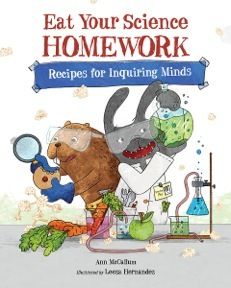Recently the Schoolhouse Review Crew were introduced to Ann McCallum Books. Ann is the author of a nifty set of books in the Eat your ... series and Nathaniel and I have been working our way through Eat Your Science Homework.
There are currently three books in the Eat Your Homework series
- Eat Your US History Homework
- Eat Your Science Homework
- Eat Your Math Homework.
What we received
- ISBN: 978-1-57091-299-3
- Published by: Charlesbridge
- Format: Paperback
- Copyright Date: 2009, 2014
- Specifications: Teacher: 48 pages
- By: Ann McCallum
- Illustrated by: Leeza Hernandez
- Awarded: Junior Library Guild Selection
- Introduction - Here you will discover all about delicious chemistry in the kitchen.
- Safety instructions - We learned about safety in our lab. The tricks of the trade list was helpful for Nathaniel. It was good to read these. I realized that some things I had not actively told him before and had assumed he knew.
- Six experiments - Each experiment covers a particular topic. We love the creative names for each one: Atomic Popcorn Balls, Density Dressing and Veggie Sticks, Invisable Ink Snack Pockets, Loop, Whorl and Arch Cookies, Sedimentary Pizza Lasagna and Black Hole Swallow-Ups
- The topic is introduced and explained carefully. The jargon is introduced in context and fully explained.
- Next the recipe is presented. There is a before you begin section which covers time, oven temperature and difficulty. An ingredients list followed by the step by step method. The author coaches the student carefully in what to do in each step.
- The next page is a conclusion to the topic page. We enjoyed reading these as they give some relevant information, interesting historical note in relation to the topic and concluding words.
- Review - This is a summary of what you have learned as you've worked your way through the book.
- Glossary - A concise list of scientific terms used throughout the book with clear explanations of each word.
- Index -
After reading the introduction page on Density, Dressing and Veggie Sticks chapter it was time to gather our supplies.
This lesson involved no heat so I left Nathaniel up to following the directions in the method. He enjoyed watching what happened as he added each ingredient to the bottle and surmising what he thought might happen when he added the ingredients.
We learned some new technical jargon: immiscible, miscible and density. We also did some follow up experiments to solidify the topic of density. The results were edible and Daddy now has some new blue salad dressing to enjoy!
You can download a fabulous Teachers Guide for Eat Your Science HOMEWORK.
Recommended Age Range
- 7-10 years old
Over All I thought ...
We've enjoyed working our way through this beautiful book. Every single double page spread is beautifully illustrated and contains thoughtful information. I appreciated how the author spoke directly to the child and did not assume that the student knew something. Every concept was clearly explained and scientific terms were presented clearly and concisely. Each experiment was followed up with a Science Sampler which ranged from finding elements present in our home to interesting information on famous scientists over the ages.
This is a fun book to add to your science routine at home and the best part is you can EAT your experiments!
Blessings
Chareen









































